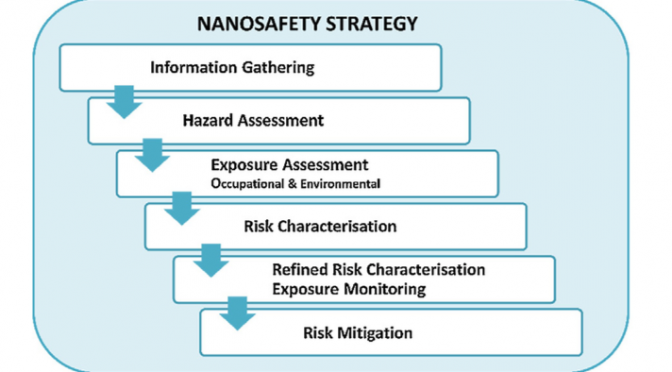The Editor’s Spotlight for the January / February 2018 issue of the Journal of Chemical Health and Safety is shining on:
A methodology on how to create a real-life relevant risk profile for a given nanomaterial
by Christa Schimpel, Susanne Resch, Guillaume Flament, David Carlander, and Izaskun Bustero
The abstract for this Open access article is:
With large amounts of nanotoxicology studies delivering contradicting results and a complex, moving regulatory framework, potential risks surrounding nanotechnology appear complex and confusing. Many researchers and workers in different sectors are dealing with nanomaterials on a day-to-day basis, and have a requirement to define their assessment/management needs.
This paper describes an industry-tailored strategy for risk assessment of nanomaterials and nano-enabled products, which builds on recent research outcomes. The approach focuses on the creation of a risk profile for a given nanomaterial (e.g., determine which materials and/or process operation pose greater risk, where these risks occur in the lifecycle, and the impact of these risks on society), using state-of-the-art safety assessment approaches/tools (ECETOC TRA, Stoffenmanager Nano and ISO/TS 12901-2:2014).
The developed nanosafety strategy takes into account cross-sectoral industrial needs and includes:
- (i) Information Gathering: Identification of nanomaterials and hazards by a demand-driven questionnaire and on-site company visits in the context of human and ecosystem exposures, considering all companies/parties/downstream users involved along the value chain;
- (ii) Hazard Assessment: Collection of all relevant and available information on the intrinsic properties of the substance (e.g., peer reviewed (eco)toxicological data, material safety data sheets), as well as identification of actual recommendations and benchmark limits for the different nano-objects in the scope of this projects;
- (iii) Exposure Assessment: Definition of industry-specific and application-specific exposure scenarios taking into account operational conditions and risk management measures;
- (iv) Risk Characterisation: Classification of the risk potential by making use of exposure estimation models (i.e., comparing estimated exposure levels with threshold levels);
- (v) Refined Risk Characterisation and Exposure Monitoring: Selection of individual exposure scenarios for exposure monitoring following the OECD Harmonized Tiered Approach to refine risk assessment;
- (vi) Risk Mitigation Strategies: Development of risk mitigation actions focusing on risk prevention.
This article and the rest of the issue can be found at ScienceDirect site
Also included in this issue of JCHAS are:
Don’t ever tell me…
Harry J. Elston
Photocatalytic degradation of phenol solution using Zinc Oxide/UV
Original research article
H. Dewidar, S.A. Nosier, A.H. El-Shazly
A methodology on how to create a real-life relevant risk profile for a given nanomaterial
Open access – Original research article
Christa Schimpel, Susanne Resch, Guillaume Flament, David Carlander, and Izaskun Bustero
A case history of legacy chemical cleanup in the lab
Original research article
L.C. Cadwallader, R.J. Pawelko
Development of custom calibration factors for respirable silica using standard methods compared to photometric monitoring data
Pages 27-35
Leon F. Pahler, Danielle D. McKenzie-Smith, Rodney G. Handy, Darrah K. Sleeth
Engineering intervention to reduce API dust exposure during milling operation
Original research article
Vivek Kanjiyangat, Manikandan Hareendran
UPCOMING EVENTS
